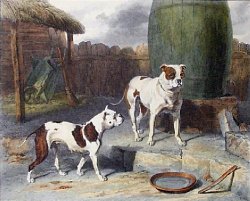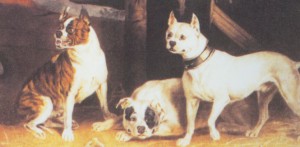Old English Bulldog
Dogs
Old English Bulldog
| Old English Bulldog |

Crib and Rosa
|
| Country of origin |
| Britain |
| Classification and breed standards |
| Not recognized by any major kennel club |
| This breed of dog is
extinct |
The Old English Bulldog is for all intents and purposes an
extinct
breed of
dog.
Appearance
The Old English Bulldog was extremely compact, broad and muscular as
reflected in the well-known depiction "Crib and Rosa." The average height was
approximately 16 inches they weighed about 45 pounds. A particular
characteristic of the breed was the lower jaw that projected considerably in
front of the upper jaw, which made possible a strong,
vice-like
grip. The nose was deeply set, which allowed the dog to get enough air as it
gripped the bull.
History
 Wasp, Child and Billy
Wasp, Child and Billy
The
English blood
sport of
bull-baiting allowed for a specialized breed in the form of the Old English
Bulldog. The main locations in
London for
these exhibitions were
Westminster Pit,
Bear Garden and
Old Conduit Fields.
Historians are fairly confident that the Old English Bulldog is derived from
ancient war dogs, such as, the old
Mastiff or
Alaunt. Others
believe that the true origin of the breed is not entirely clear. One safe theory
is that the Bulldog was first developed in the
British Isles and was originally bred for the sole purpose of
bull-baiting.
In England, the passage of the
Humane Act of 1835 caused a decline of bull-baiting and
dog
fighting leading to a lack of interest in perpetuating the Old English
Bulldog. Three dogs from the
Duke of Hamilton's strain of Old English Bulldog, 'Wasp, Child, and Billy,'
were famously depicted in a painting and recognized as some of the last known
members of the breed before they became
extinct.
Two other recognized members of the breed 'Crib and Rosa' can be seen in a
painting of that period, with Rosa being considered to represent perfection in
the shape, make, and size of the ideal type of Old English Bulldog; however,
being deficient in wrinkles about the head and neck and in substance of bone in
the limbs.
Despite the laws making dog fighting
illegal the
activity continued for many years. Breeders determined a cross between the Old
English Bulldog and
Terrier
created a superior fighting dog with increased quickness and dexterity. This new
breed of dog called the
Bull and Terrier and precurser to the
Bull
Terrier and
Pit Bull Terrier accelerated the extinction of the Old English Bulldog.
Reincarnations
Several breeders are attempting to recreate this extinct breed with some
success. However, it should be noted that these recreations are not the Old
English Bulldog, as the genetics from this breed are extinct.
Wilkinson Bulldog
- Main articles:
Wilkinson Bulldog
Lolly Wilkinson of
Vancouver Island,
British Columbia,
Canada, has
been breeding a strain of Bulldog referred to as the
Wilkinson Bulldog, for many years that is similar to the Old English
Bulldog. Due to the small number of bulldogs and the potential for
inbreeding
it is of questionable quality. In addition, the breed is not recognized by any
major kennels.Its form is most similar to the old English Bulldog hence its
alternate name-Original English Bulldog. Although the Wilkinsons claim that it
is a healthy breed and suffers few genetic diseases. Whether this breed will
gain worldwide popularity and more people accept that this is the real
Bulldog,remains to be seen.
Olde English Bulldogge
- Main articles:
Olde English Bulldogge
The contemporary recreation of the breed is called the
Olde English Bulldogge. A well-researched line-breeding program, with the
aim of recreating the Old English Bulldog, was started in the 1970s. This modern
day version with its similar physical abilities does not include the violent
temperament of the Old English Bulldog. This recreation was done by inter
breeding the healthiest bulldogs,
Bullmastiffs and
Pitbulls.
Others
There are several other recreations but none have become popular, including
but not limited too,
Dorset Thyme Bulldog,
Victorian Bulldog and
Renaissance Bulldog.
English Bulldog
Often confused with the Old English Bulldog, the
English Bulldog may be a fine animal to own for its sweet disposition, but
it has maintained nothing of the tenacity, speed, and agility that were the
definitive characteristics of the Old English Bulldog.
Books
- McDonald,Joan. The Book of the Bulldog,
Neptune, NJ:TFH Publications,
ISBN 0866220275
- Jenkins, Robert. The Story of the Real Bulldog
Neptune, NJ: TFH Publications,
ISBN 0793804914
See also
List of dog fighting breeds
Home | Up | Alaunt | Black and Tan Terrier | Blue Paul Terrier | Cordoba Fighting Dog | English White Terrier | Molossus | Old English Bulldog | St. John's Water Dog | Talbot
Dogs, made by MultiMedia | Free content and software
This guide is licensed under the GNU
Free Documentation License. It uses material from the Wikipedia.
|




